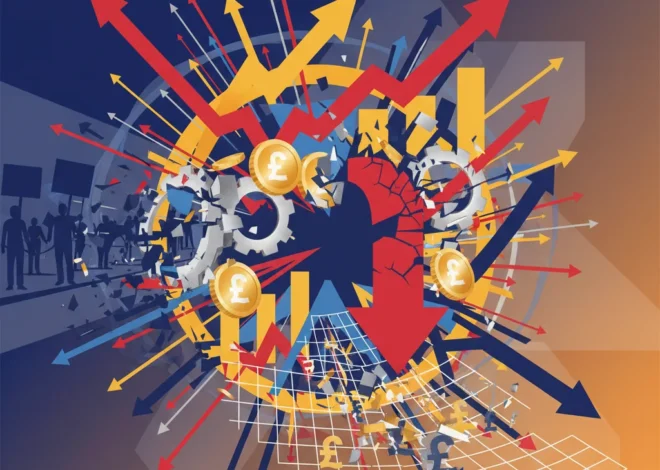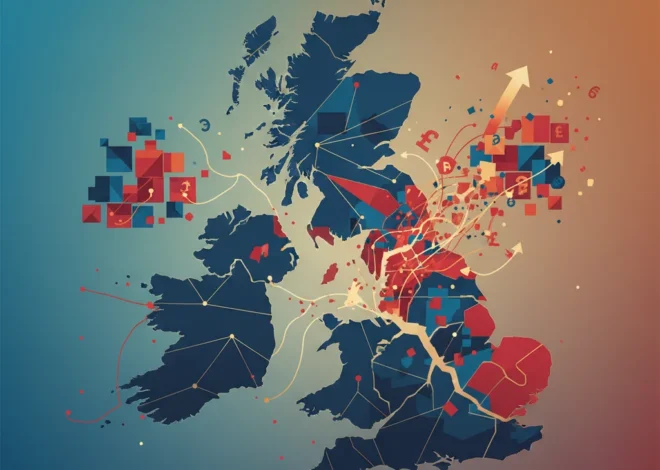
Beyond the Headlines: What a Sudden Crisis Teaches Investors About Market Shocks and Financial Resilience
In a world saturated with data and real-time information, we often feel a sense of control. Our trading algorithms are optimized, our economic models are sophisticated, and our business forecasts are meticulously planned. Yet, the veneer of predictability can be shattered in an instant. A recent, jarring incident serves as a stark, small-scale metaphor for the large-scale disruptions that can upend markets and economies: a seemingly normal train journey north of London was violently interrupted by multiple stabbings near Huntingdon, leading to two arrests.
For the passengers on that train, the world shifted from mundane to terrifying in a matter of moments. Their planned journey, their sense of security, their immediate reality—all were irrevocably altered by an unforeseen event. While the human tragedy of such an event is paramount, for leaders in finance, business, and investing, it offers a powerful lesson in systemic fragility and the critical importance of preparing for the unthinkable. This is the essence of navigating “Black Swan” events—high-impact, hard-to-predict, and rare occurrences that are beyond the realm of normal expectations in history, science, finance, and technology.
Just as a single act of violence can halt a transportation network, a single point of failure in the global financial system can trigger a cascade of consequences. In this analysis, we will move beyond the immediate headline to explore the anatomy of market shocks, the mechanisms of financial contagion, and the modern strategies, powered by financial technology, that can help build resilience in an inherently unpredictable world.
The Anatomy of a Black Swan: From a Train Car to the Stock Market
The term “Black Swan,” popularized by essayist and former options trader Nassim Nicholas Taleb, describes events that come as a complete surprise and have a major effect. After the fact, they are often inappropriately rationalized with the benefit of hindsight. The 2008 global financial crisis, the bursting of the dot-com bubble in 2000, and the rapid global shutdown at the onset of the COVID-19 pandemic are all textbook examples that roiled the global economy.
What these events share with the incident at Huntingdon is the sudden violation of underlying assumptions. Passengers assume a safe commute. Investors, in the run-up to 2008, assumed that housing prices would never fall on a national scale. Tech entrepreneurs in 1999 assumed that “eyeballs” would inevitably translate to profit. These assumptions create blind spots, leaving systems vulnerable to shocks.
Understanding the structure of these shocks is the first step toward mitigating them. We can compare two of the most significant market events of the 21st century to see their distinct characteristics but similar devastating potential.
Below is a comparative analysis of the 2008 Financial Crisis and the 2020 COVID-19 Market Crash.
| Characteristic | 2008 Global Financial Crisis | 2020 COVID-19 Market Crash |
|---|---|---|
| Primary Cause | Systemic failure in the banking and housing sectors (subprime mortgages, CDOs). | Exogenous shock from a global pandemic, leading to government-mandated economic shutdowns. |
| Nature of Shock | Endogenous; originated from within the financial system itself. A crisis of leverage and credit. | Exogenous; originated from outside the financial system. A crisis of public health and supply chains. |
| Speed of Onset | Slow burn over months as institutions like Bear Stearns and Lehman Brothers failed. | Extremely rapid; the S&P 500 fell 34% in just 33 days (source). |
| Central Bank Response | Bailouts (TARP), quantitative easing (QE), and slashing interest rates to near-zero. | Unprecedented monetary and fiscal stimulus, including direct payments, PPP loans, and massive QE. |
| Market Recovery | Slow and protracted. It took the S&P 500 over five years to reclaim its pre-crisis peak. | Remarkably fast (V-shaped recovery), with markets hitting new highs within months due to stimulus. |
Each crisis demonstrates a different flavor of systemic risk, but the core lesson is the same: the interconnectedness of our modern stock market and economy means that a failure in one domain—be it subprime mortgages or global logistics—can create unpredictable and widespread fallout.
AI Hype and Hidden Debt: Are We on the Brink of the Next Financial Crisis?
Financial Contagion: When One Disruption Derails the Entire System
When the train at Huntingdon was stopped, the disruption was not confined to that single carriage. The entire line was likely halted, affecting thousands of commuters, delaying deliveries, and causing a ripple effect of logistical chaos. This is a microcosm of financial contagion.
In the world of finance, contagion is the spread of a market disturbance—often negative—from one country or financial institution to others. The 2008 crisis is the quintessential example. The failure of Lehman Brothers, a single investment bank, did not happen in a vacuum. It triggered a crisis of confidence across the entire financial sector. Banks stopped lending to each other due to a lack of trust, freezing credit markets and starving even healthy businesses of the capital they needed to operate. This is systemic risk in action: the risk that the failure of one component will trigger the collapse of the entire system.
Today, the channels for contagion are more numerous than ever:
- Interbank Lending: Banks are deeply interconnected through lending, making one institution’s liquidity problems another’s solvency crisis.
- Globalization: A slowdown in one major economy, like China, can immediately impact global supply chains and commodity prices, affecting corporate earnings worldwide.
- High-Frequency Trading: Algorithmic trading can amplify volatility. A sell-off can trigger other algorithms to sell, creating a downward spiral in milliseconds, as seen in various “flash crashes.”
- Derivative Markets: Complex financial instruments link the fates of seemingly unrelated assets, creating hidden correlations that only become apparent during a crisis.
Building a Resilient Portfolio: Modern Defenses Against the Unforeseen
If we accept that shocks are inevitable, the focus must shift from prediction to preparation. For investors and financial managers, this means building resilience directly into their strategies and portfolios. The old wisdom of simple diversification (e.g., a 60/40 stock/bond split) is still relevant but may no longer be sufficient in a world of correlated assets and complex risks.
Modern resilience involves a multi-layered approach, incorporating traditional principles with innovations from the world of financial technology. This includes dynamic asset allocation, sophisticated hedging techniques, and an embrace of alternative asset classes that may have lower correlation to public markets.
According to a report by PwC on financial services technology, firms are increasingly leveraging technology to move from a reactive to a proactive risk management posture. This is where fintech becomes a crucial part of the resilience toolkit.
Beyond the Banners: What the Edinburgh Protests Mean for the Global Economy and Your Portfolio
Here’s a look at how portfolio defense strategies have evolved:
| Strategy Area | Traditional Approach | Modern / Fintech-Enabled Approach |
|---|---|---|
| Diversification | Static allocation across stocks, bonds, and cash. | Dynamic asset allocation using algorithms; inclusion of alternative assets like private credit, infrastructure, and digital assets (e.g., via blockchain). |
| Hedging | Buying put options on broad market indices (e.g., S&P 500). | Sophisticated options strategies, volatility derivatives (e.g., VIX futures), and using AI to identify and hedge against specific factor risks. |
| Risk Analysis | Value at Risk (VaR) models based on historical data. | Real-time scenario analysis, AI-powered stress testing, and machine learning models that detect anomalies and shifting correlations in live market data. |
| Information Flow | Relying on quarterly earnings reports and major news outlets. | Leveraging alternative data sources (e.g., satellite imagery, credit card transactions, social media sentiment) to gain an information edge. |
The Future of Risk Management: Fintech, AI, and a New Paradigm
The rise of fintech is fundamentally changing the landscape of risk management. Where institutions once relied on historical data and human intuition, they can now deploy powerful computational tools to model the future with greater sophistication. This isn’t about finding a crystal ball; it’s about building a better early-warning system.
Key innovations include:
- Predictive Analytics and AI: Machine learning algorithms can analyze vast datasets to identify subtle patterns that may precede a market downturn. They can flag unusual trading activity, shifts in credit risk, or changes in macroeconomic sentiment far faster than human analysts.
- Blockchain and Decentralization: While still a volatile asset class, the technology underpinning cryptocurrencies offers a new model for financial infrastructure. A decentralized ledger, in theory, can reduce single points of failure and increase transparency in transactions, potentially mitigating certain types of systemic risk seen in the traditional banking system. However, it also introduces new risks related to smart contract vulnerabilities and regulatory uncertainty.
- RegTech (Regulatory Technology): A growing subset of fintech, RegTech helps financial institutions comply with regulations more efficiently. By automating compliance and monitoring, these tools can help prevent the kinds of institutional failures and rule-bending that often lie at the heart of financial crises.
These technologies empower investors and institutions to move from a defensive crouch to a state of proactive readiness. They allow for the continuous stress-testing of portfolios against a myriad of potential shocks, enabling smarter, faster decisions when a crisis, like the one on the train to Huntingdon, inevitably occurs.
A Tax on Prudence? Unpacking the Rumored Cuts to the UK's Cash ISA Allowance
Conclusion: The Enduring Lesson of Unpredictability
The journey from a violent, isolated incident on a train to the complex world of global finance may seem long, but the connecting thread is a fundamental truth: our systems are more fragile than we think, and true security lies not in the avoidance of risk, but in the cultivation of resilience. The tragic event near Huntingdon is a brutal reminder that the unexpected can and will happen.
For investors, business leaders, and financial professionals, the lesson is clear. We must build organizations and strategies that can withstand shocks, adapt to rapidly changing conditions, and operate with a healthy respect for the unknown. This requires more than just better algorithms or more diverse assets. It requires a mindset shift—an acknowledgment that the next Black Swan is always out there, swimming just beyond the horizon. By embracing modern tools, fostering a culture of rigorous risk management, and never taking stability for granted, we can prepare not just to survive the next crisis, but to emerge from it stronger.


